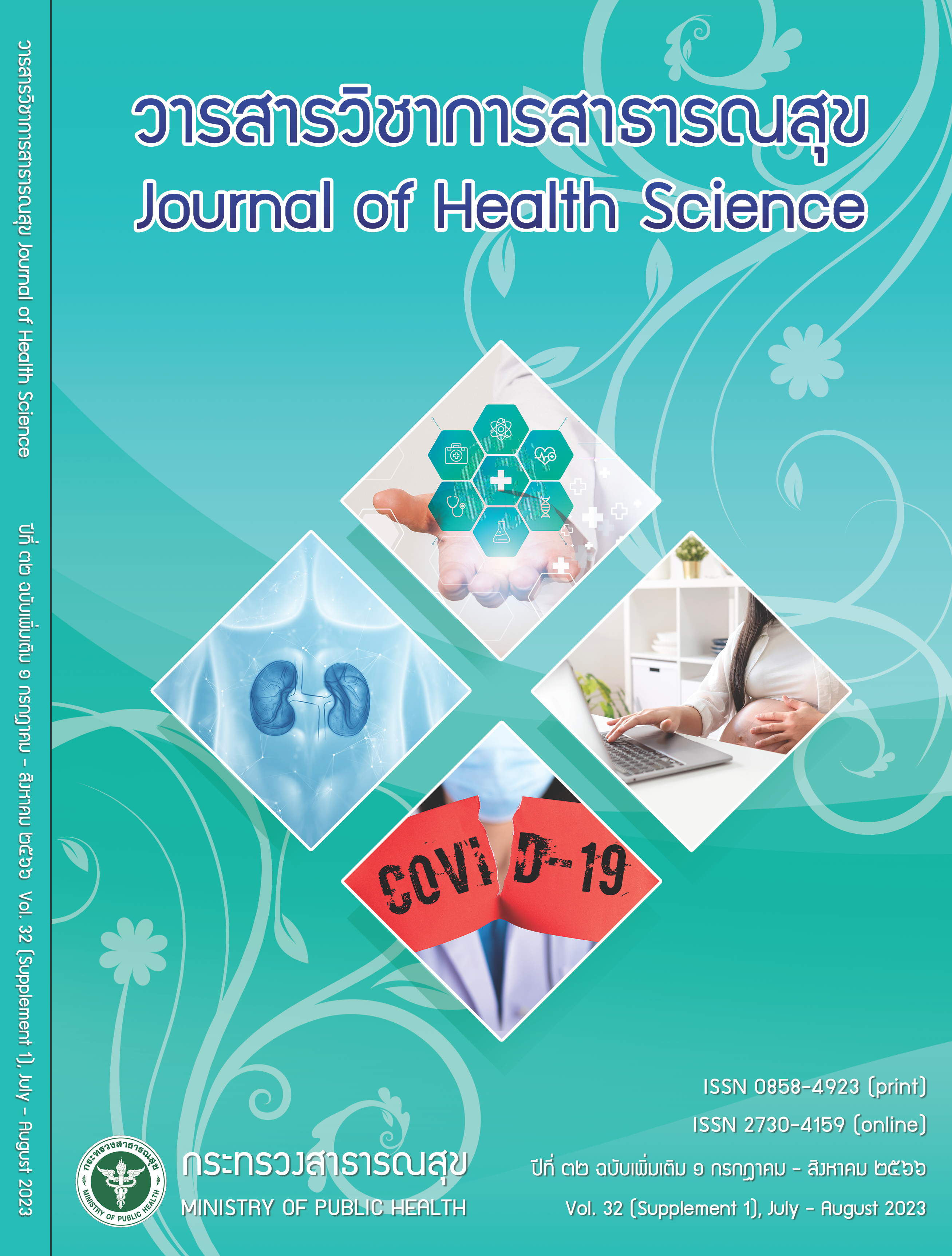Model Development in Good Health Promotion, New Lifestyle, Dharma Lifestyle, Thai Lifestyle, Sufficiency Economy Lifestyle for Muslim Diabetics
Keywords:
diabetes, hypertension, health promoting model, Muslim diabetic patientsAbstract
This research and development aimed to develop a model, study the effectiveness in creating good health, new lifestyle, dharma lifestyle, Thai lifestyle, sufficiency economy lifestyle in controlling blood sugar levels in Muslim diabetic patients after creating good health; and study the satisfaction on the model among diabetic patients. It was conducted during 20 March – 23 June 2023. The samples were diabetic patients who came to 6 sub-district health promoting hospitals in Mai Kaen district and Mai Kaen hospital, Pattani Province, Thailand. They were selected by purposive sampling; and were divided into an experimental group of 48 people, and a comparison group of 48 people. Data on practice measurement of 3Sor (praying, reading the Qur’an [concentration], and contemplating Dharma), 3Orr (food, exercise, and mood) and 1Nor (life clock) were collected by using health promoting form, health status record form and health measurement/assessment tools (weighing machine, height meter, tape measure around the waist, and blood glucose meter (DTX). Data analysis was performed by descriptive statistics, Chisquare test and t-test. It was found that the developed health promoting model consisted of training and practice of good health promotion followed by daily self-practice on 3Sor, 3Orr, and 1Nor (life clock); application of the philosophy of sufficiency economy in life, follow up, continuous and periodic empowerment of the diabetic patients, and evaluation. As a result, the experimental group had better understanding on the illness, and developed health behavior resulting in the improvement of body mass index, waist circumference, and blood sugar levels when compared to the status before the program, and better than those of the comparison group (p<0.05). In addition, 64.6% of the patients were able to control blood sugar levels; and 81.2% of them were very satisfied with the model. Thus, this new health promoting model is effective and should be applied for health promotion among Muslim diabetic patients.
Downloads
References
วรรณี นิธิยานันท์. ไทยป่วยเบาหวานพุ่งสูงต่อเนื่องแตะ 4.8 ล้านคน ชี้ ‘เนือยนิ่ง-อ้วน-อายุมาก’ ต้นเหตุ [อินเทอร์เน็ต]. 2565 [สืบค้นเมื่อ 10 ส.ค. 2565]. แหล่งข้อมูล: https:// www.hfocus.org/content/2019/11/18014
อัมพา สุทธิจำรูญ. มาตรฐานคลินิกเบาหวานของประเทศไทย. วารสารเบาหวาน 2565;54(1):19-22.
สมาคมโรคเบาหวานแห่งประเทศไทย. 2560. รู้จักโรคเบาหวาน [อินเทอร์เน็ต]. 2560 [สืบค้นเมื่อ 10 มิ.ย. 2565]. แหล่งข้อมูล: http://www. Dmthai.org/news and_knowledge/88
Trikkalinou A, Papazafiropoulou AK, Melidonis A. Type 2 diabetes and quality of life. World Journal of Diabetes 2017;8(4):120-9.
American Diabetes Association. Standards of medical care for patients with diabetes mellitus. Diabetes Care 2017; 30:34-40.
สำนักบริหารยุทธศาสตร์สุขภาพดีวิถีชีวิตไทย. คู่มือการ ดำเนินงานโครงการพัฒนากลไกสนับสนุนวิชาการ และ เครือข่ายขับเคลื่อนนโยบายสุขภาพดี วิถีใหม่ วิถีธรรม วิถีไทย วิถีเศรษฐกิจพอเพียง. นนทบุรี: เดอะกราฟิโก; 2564.
สำนักงานเขตสุขภาพที่ 12. รายงานผู้ป่วยโรคเบาหวาน. สงขลา: สำนักงานเขตสุขภาพที่ 12; 2565.
Dey KP, Hariharan S. Integrated approach to healthcare Quality management: A case study. The TQM Magazine 2006;18(6):583-605.
จรณิต แก้วกังวาล, ประตาป สิงหศิวานนท์. ขนาดกลุ่มตัวอย่างในการวิจัยทางคลินิก ในตำราการวิจัยทางคลินิกคณะเวชศาสตร์เขตร้อน มหาวิทยาลัยมหิดล. กรุงเทพมหานคร: อมรินทร์พริ้นติ้งแอนด์พับลิชชิ่ง. 2554.
ธีรพจน์ ฟักน้อย. การพัฒนาระบบการดูแลผู้ป่วยโรคเบาหวาน ของเครือข่ายบริการสุขภาพ อำเภอบึงสามพัน จังหวัดเพชรบูรณ์. วารสารโรงพยาบาลนครพิงค์ 2565; 13(2):27-46.
อุทัย สุดสุข, ธีรพร สถิรอังกูร, พัชรีย์ กลัดจอมพงษ์, บุษบา ใจกล้า. พัฒนารูปแบบการสร้างเสริมสุขภาพดีวิถีพุทธเพื่อ ป้ องกันและควบคุมโรคไม่ติดต่อเรื้อรัง. วารสารวิชาการสาธารณสุข 2564;30(3):438-50.
World Health Assembly. Strengthening integrated, people-centred health services. WHA 2016;69(24):90-5.
วรรณรา ชื่นวัฒนา, ณิชานาฏ สอนภักดี. พฤติกรรมการดูแล สุขภาพตนเองของผู้ป่วยโรคเบาหวาน ตำบลบางแม่นาง อำเภอบางใหญ่ จังหวัดนนทบุรี. วารสารวิชาการมหาวิทยาลัยปทุมธานี 2557;6(3):163-70.
สำนักบริหารยุทธศาสตร์สุขภาพดีวิถีชีวิตไทย. การอบรม วิทยากรเพื่อการสร้างเสริมสุขภาพ ป้ องกันและควบคุมโรค ไม่ติดต่อเรื้อรังและโรคติดเชื้อไวรัสโคโรนา 2019 (โควิด19). นนทบุรี: เดอะกราฟิโก; 2564.
แพทย์พงษ์ วรพงศ์พิเชษฐ์. สวดมนต์และสมาธิบำบัดเพื่อ การรักษาโรค. นนทบุรี: กองการแพทย์ทางเลือก กรมการแพทย์แผนไทยและการแพทย์ทางเลือก; 2558.
กิจจ์ศรัณย์ จันทร์โป๊. ผลการสวดมนต์ตามแนวพุทธศาสนา และการทำสมาธิแบบอานาปานสติ ที่มีความเครียด ของนิสิต จุฬาลงกรณ์มหาวิทยาลัย. กรุงเทพมหานคร: จุฬาลงกรณ์มหาวิทยาลัย. 2556.
Downloads
Published
How to Cite
Issue
Section
License

This work is licensed under a Creative Commons Attribution-NonCommercial-NoDerivatives 4.0 International License.







